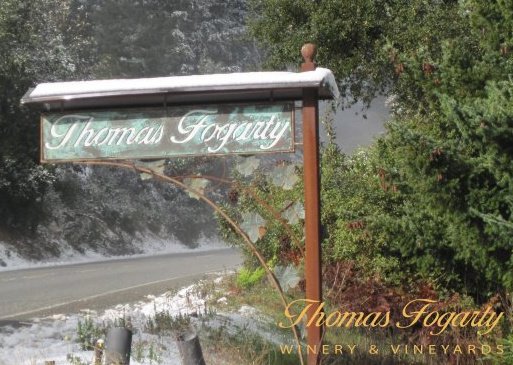 Thomas Fogarty Winery located in the Santa Cruz Mountains is a producer I’ve been impressed with over the last few years. They have been making wine since 1981.Their portfolio includes a wide range of offerings but Pinot Noir and Chardonnay stand at the core of what they do. With both varietals they make a host of selections, both single vineyard offerings and cuvee style wines. The single vineyard offerings, which are the heart of their portfolio in many ways, allow them to highlight the unique sense of place and time that separates one vineyard from another and one vintage to the next. Today I’m going to look at six distinct Chardonnay releases from them; 4 single vineyard selections and 2 cuvee style offerings.
First up is the Thomas Fogarty 2007 Santa Cruz Mountains Chardonnay. Fruit for this wine was sourced from three vineyards; Winery Estate (89%), Gist Estate (8%) and Camel Hill (3%). This wine was aged in French oak for 10 months. Just fewer than 2,600 cases of this wine were produced and it has a suggested retail price of $29.00.
Thomas Fogarty Winery located in the Santa Cruz Mountains is a producer I’ve been impressed with over the last few years. They have been making wine since 1981.Their portfolio includes a wide range of offerings but Pinot Noir and Chardonnay stand at the core of what they do. With both varietals they make a host of selections, both single vineyard offerings and cuvee style wines. The single vineyard offerings, which are the heart of their portfolio in many ways, allow them to highlight the unique sense of place and time that separates one vineyard from another and one vintage to the next. Today I’m going to look at six distinct Chardonnay releases from them; 4 single vineyard selections and 2 cuvee style offerings.
First up is the Thomas Fogarty 2007 Santa Cruz Mountains Chardonnay. Fruit for this wine was sourced from three vineyards; Winery Estate (89%), Gist Estate (8%) and Camel Hill (3%). This wine was aged in French oak for 10 months. Just fewer than 2,600 cases of this wine were produced and it has a suggested retail price of $29.00.
Citrus aromas are underscored by a hint of toast in the nose of this Chardonnay. Orchard fruit and lemon cream flavors are on display through the palate which is dominated by a pure blast of fruit. Nutmeg and baker’s spice emerges and carries through the finish which is crisp and refreshing with solid length. Fine acidity makes this a food lovers wine. This is the most widely available of the Fogarty Chardonnays and it’s a fine example of mountain Chardonnay with depth, and balance to spare.
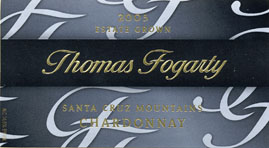 The Thomas Fogarty 2007 Estate Chardonnay was produced using barrel selection from two of their estate vineyards; Damiana and Langley Hill. Half of the fruit comes from each vineyard. This wine was aged in French oak for 16 months; 30% of the barrels were new. This wine has a suggested retail price of $37.
The Thomas Fogarty 2007 Estate Chardonnay was produced using barrel selection from two of their estate vineyards; Damiana and Langley Hill. Half of the fruit comes from each vineyard. This wine was aged in French oak for 16 months; 30% of the barrels were new. This wine has a suggested retail price of $37.
Pineapple, Golden Delicious Apple and gentle wisps of vanilla fill the effusive nose of this Chardonnay. Orchard and tropical fruit themes continue through the palate where they’re joined by stone fruit in the form of apricot and white peach. These flavors come together to from a core of fresh, vibrant flavors. They lead to the finish which shows off minerals, apple pie spices, toasty oak and solid acidity. This wine has a bit more complexity than the SCM Chardonnay. At three years old this offering is actually on the young side. If you have the patience to lay it down for a year or two you’ll be rewarded with an even lovelier wine.
The Thomas Fogarty 2007 Portola Springs Estate Chardonnay is a single vineyard effort with 100% of the fruit sourced at the vineyard of the same name. Portola Springs Estate Vineyard sits 10 miles from the ocean at an elevation of 1,920 feet above sea level. This selection was aged in all French oak for 18 months; 50% of the barrels were new. Less than 75 cases of this wine were produced and it sells for $48.
A wisp of candied apple emerges from the nose of this Chardonnay and beckons you to take a sip. Pear, apple, pineapple and lemon zest underscored by a touch of crème all make their presence felt in the palate of this Chardonnay. Apple pie spices emerge on the finish along with tart green apple and some savory fruit notes. This wine has solid acidity. It takes a bit of air for this wine to really show its charms. Of these wines, particularly the single vineyard offerings, the Portola Springs is perhaps the most reserved and austere.
The Thomas Fogarty 2007 Langley Hill Estate Chardonnay was produced using fruit from the vineyard of the same name. Langley Hill is Thomas Fogarty’s largest estate vineyard at just over 5 acres. It sits 10 miles from the ocean at an elevation of 1,920 feet. This wine was aged over 18 months in French oak; half the barrels were new. Less than 100 cases of this selection were produced and it has a suggested retail price of $48.
Aromas of citrus fruit join golden delicious apple characteristics in the engaging nose of this Chardonnay. Tropical fruits such as mango and pineapple lead an impressive plate which is fruity, full-bodied and loaded with spice notes such as nutmeg and clove. Lush fruit characteristics continue through the finish which continues the spice parade along with hints of Crème brûlée and a who’s who of mineral notes in droves. The finish is lengthy enough to be both impressive and noteworthy.
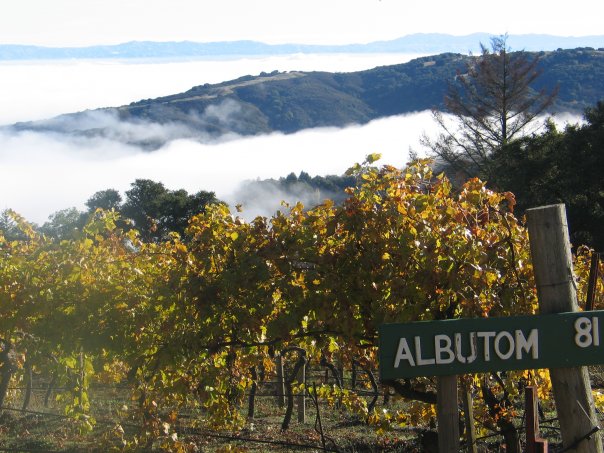 The Thomas Fogarty 2007 Albutom Estate Chardonnay is a single vineyard offering. 100% of the fruit was sourced from the namesake vineyard. Albutom Vineyard sits 10 miles from the ocean at an elevation of 1930 feet. This wine was aged for 18 months in French oak; 50% of the barrels were new. Fewer than 50 cases of this selection were produced and it sells for $48.
The Thomas Fogarty 2007 Albutom Estate Chardonnay is a single vineyard offering. 100% of the fruit was sourced from the namesake vineyard. Albutom Vineyard sits 10 miles from the ocean at an elevation of 1930 feet. This wine was aged for 18 months in French oak; 50% of the barrels were new. Fewer than 50 cases of this selection were produced and it sells for $48.
Asian pear leads the nose of this single vineyard effort. It’s underscored by a solid whiff of spices. The pear theme continues through the palate where Anjou pear flavors rule the day. White pepper and pineapple flavors with a sour fruit element mark the finish followed by toasty oak notes. This wine has a nice acidic bite. This selection is perhaps the most outgoing of these wines. The fruit is a bit more powerful and heftier than the other three single vineyard offerings. Yet, as with every wine I have tasted in their portfolio, it retains balance.
The Thomas Fogarty 2007 Damiana Vineyard Estate Chardonnay was produced using fruit sourced exclusively from the vineyard of the same name. Planted in 1978, this is their oldest vineyard. This selection was barrel aged in new French oak for approximately 18 months. Fewer than 100 cases were produced and it has a suggested retail price of $48.
Inviting fall aromas of apple pie spice and orchard fruit in general emerge generously from the nose of this Chardonnay. The fruit notes throughout the palate are bold, powerful and engaging in nature. Hints of citrus join the orchard flavors along with some yellow and green melon. Hazelnut, white pepper and minerals join toasty oak on a long, lusty and impressive close. This wine has vibrant acidity.
I had the good fortune to sample these wines side by side in a horizontal tasting. Doing so was educational and fascinating as well as rewarding. I learned a lot about the differences in the Thomas Fogarty Vineyards as well as how the subtly different ways they treated each wine helped bring the intrinsic characteristics to the forefront. Most enlightening was the differences between these wines. You might wonder how different six Chardonnays from the same producer, each from their own vineyards might be. Each of these wines is remarkably different and distinct. If you’re a Chardonnay lover you owe it to yourself to try these wines side by side if you can. Another impressive element is that each of these wines will drink well for a number of years. The average shelf life will be 3-5 years but a couple of the single vineyard efforts will go a bit longer.
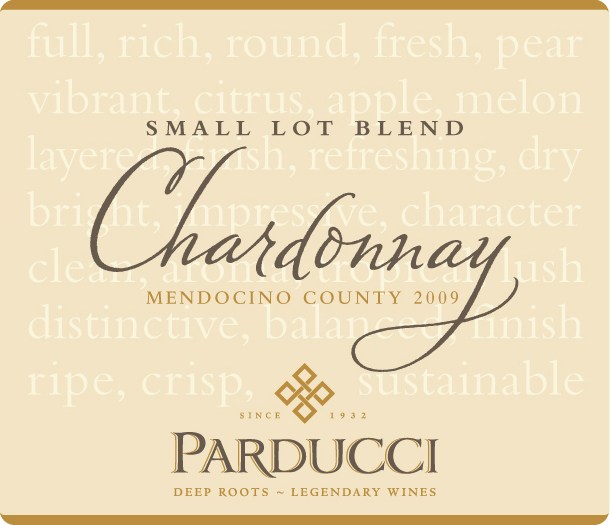 Parducci Wine Cellars has a lot going for it. They’re a Mendocino County producer that has been around for quite a long time. In their history they’ve seen and done a lot. What they have been doing of late is producing vintage after vintage of well made, varietally correct wines that are perfect for everyday consumption. These are budget friendly wines that are generally available all over the country. Today I’ll look at their current release of Chardonnay.
The Parducci 2010 Small Lot Blend Chardonnay was produced from fruit sourced in their home appellation of Mendocino County. The fruit was picked, fermented and vinified in small lots. Aging was accomplished over 8 months in a combination of stainless steel (95%) and used French oak (5%). Afterwards select lots were blended together to create this wine. This nationally available selection has a suggested retail price of $10.99.
Parducci Wine Cellars has a lot going for it. They’re a Mendocino County producer that has been around for quite a long time. In their history they’ve seen and done a lot. What they have been doing of late is producing vintage after vintage of well made, varietally correct wines that are perfect for everyday consumption. These are budget friendly wines that are generally available all over the country. Today I’ll look at their current release of Chardonnay.
The Parducci 2010 Small Lot Blend Chardonnay was produced from fruit sourced in their home appellation of Mendocino County. The fruit was picked, fermented and vinified in small lots. Aging was accomplished over 8 months in a combination of stainless steel (95%) and used French oak (5%). Afterwards select lots were blended together to create this wine. This nationally available selection has a suggested retail price of $10.99.
 Jacob’s Creek is one of those Australian brands that is widely available on US shelves; so it’s likely their packaging and logo have some familiarity to wine lovers. Vintage to vintage they tend to release wines that showcase individual personality and the genuine variation expected in vineyard driven releases. Today I’ll look at two of their current wines.
The Jacob’s Creek 2010 Reserve Chardonnay was produced from fruit sourced in the Adelaide Hills region ofAustralia. This widely available offering has a suggested retail price of $12.99 and often sells for closer to $10.
Jacob’s Creek is one of those Australian brands that is widely available on US shelves; so it’s likely their packaging and logo have some familiarity to wine lovers. Vintage to vintage they tend to release wines that showcase individual personality and the genuine variation expected in vineyard driven releases. Today I’ll look at two of their current wines.
The Jacob’s Creek 2010 Reserve Chardonnay was produced from fruit sourced in the Adelaide Hills region ofAustralia. This widely available offering has a suggested retail price of $12.99 and often sells for closer to $10.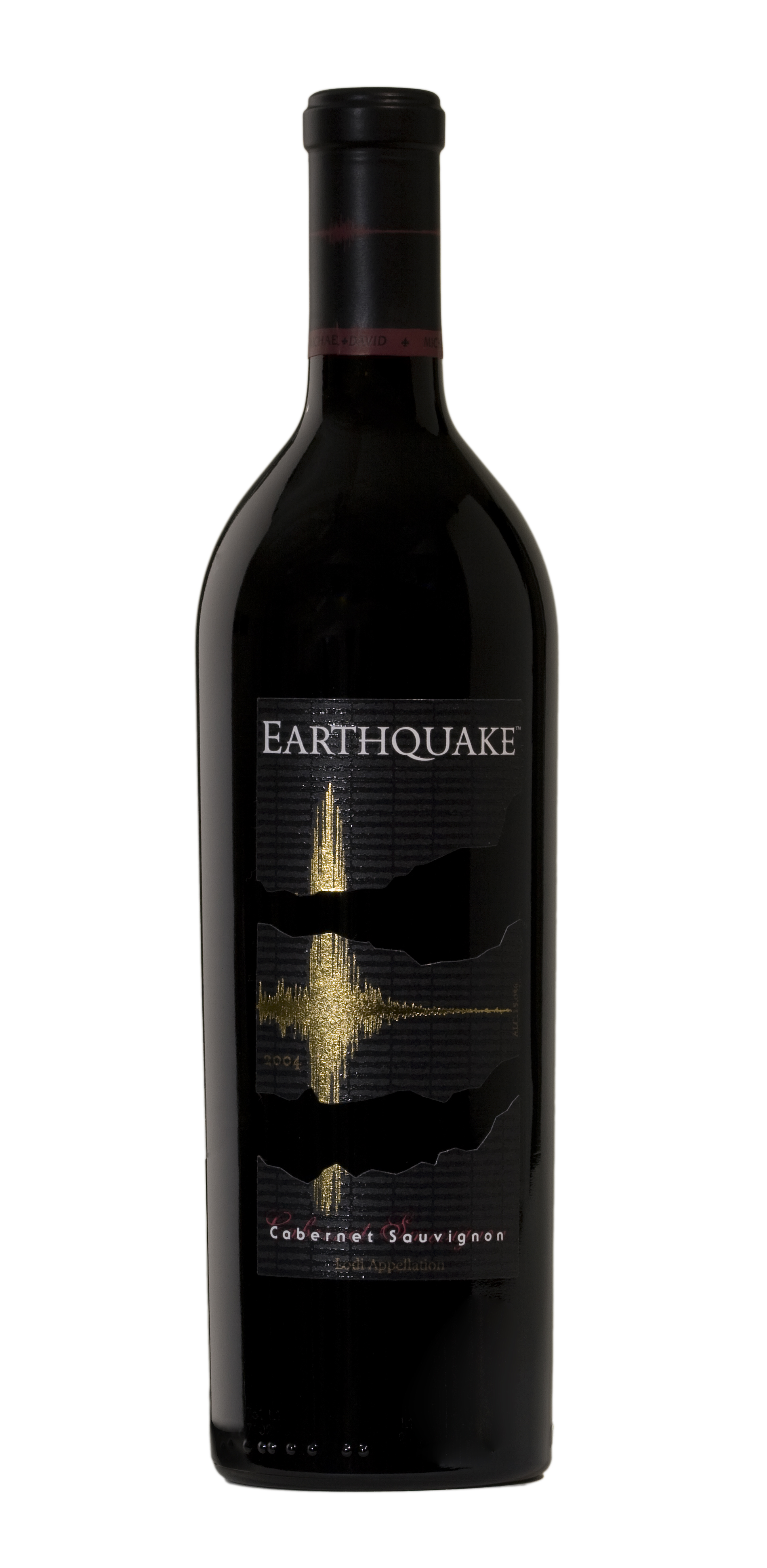 Michael David Winery makes a wide array of offerings from fruit sourced in their native region of Lodi California. Their focus is the production of engaging, fruit forward wines loaded with flavor and curb appeal. The offerings the make are widely available across the country at a cross section of budget friendly prices. Today I’ll look at two of their current release offerings.
The Michael David Winery 2010 Incognito White was produced using fruit sourced in the Lodi California Appellation. This wine is a blend of Viognier (63%), Chardonnay (21%),Muscat (7%), Sauvignon Blanc (5%) and Roussanne (4%). Incognito White was fermented and aged in stainless steel; this offering had no oak contact. The suggested retail price for this widely available wine is $18.
Michael David Winery makes a wide array of offerings from fruit sourced in their native region of Lodi California. Their focus is the production of engaging, fruit forward wines loaded with flavor and curb appeal. The offerings the make are widely available across the country at a cross section of budget friendly prices. Today I’ll look at two of their current release offerings.
The Michael David Winery 2010 Incognito White was produced using fruit sourced in the Lodi California Appellation. This wine is a blend of Viognier (63%), Chardonnay (21%),Muscat (7%), Sauvignon Blanc (5%) and Roussanne (4%). Incognito White was fermented and aged in stainless steel; this offering had no oak contact. The suggested retail price for this widely available wine is $18.
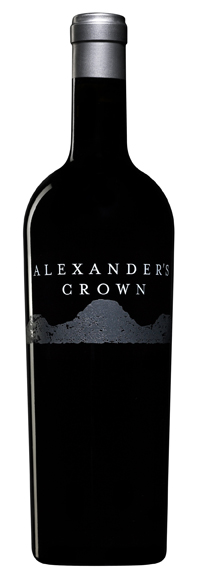
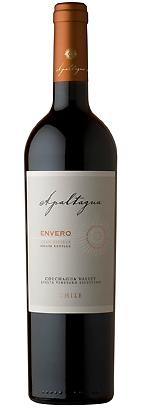
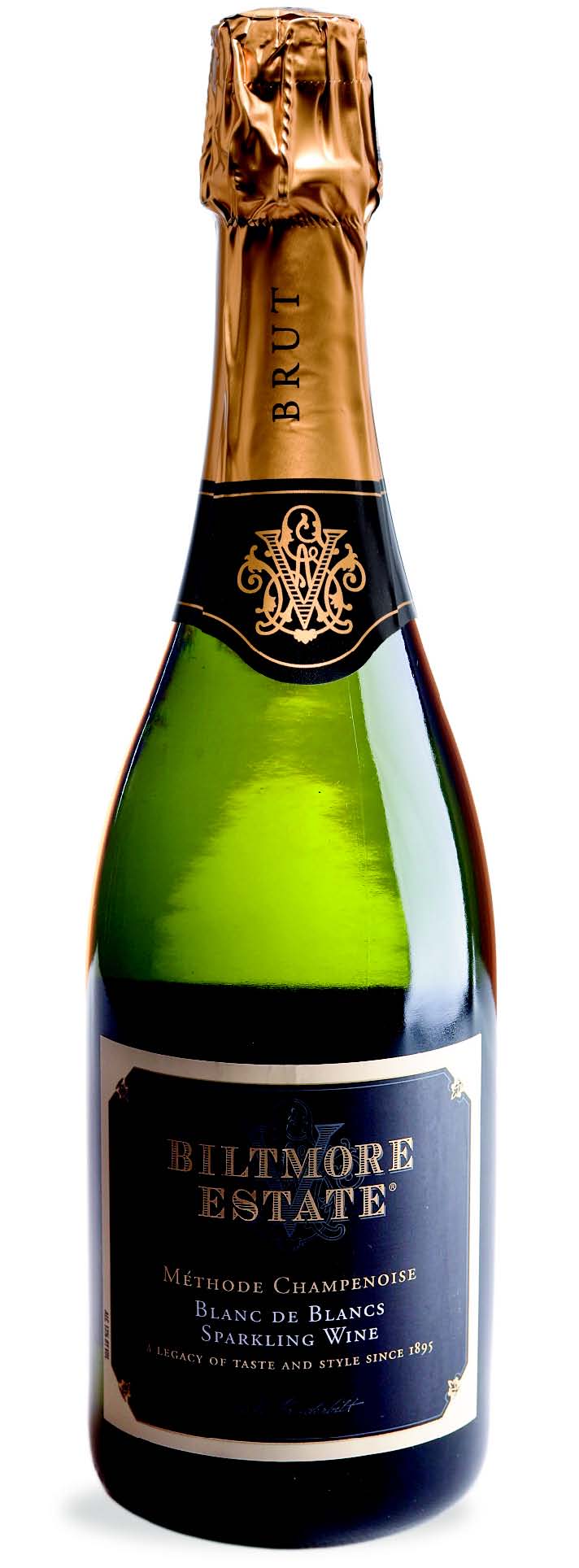




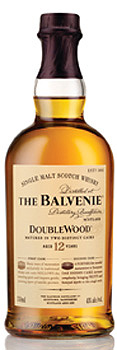
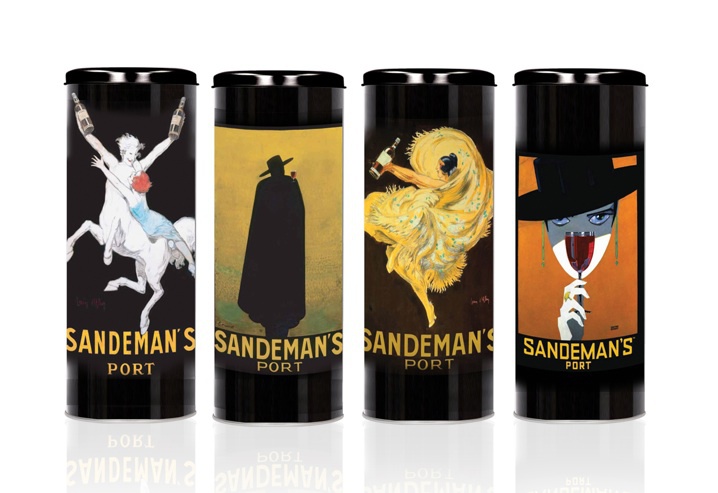
 Do you like Chardonnay? That’s a loaded question I know. Your answer is probably a return question asking what sort, or style of Chardonnay I’m talking about. There might not be another grape that is so wildly popular on the one hand and inspires so much debate on the other. The basic concept folks tend to wrestle with when it comes to this grape is oak treatment. What has become known in many circles as “California Style Chardonnay” is what really gets a lot of people talking. The trouble with that term is that it only describes a very small amount of Chardonnay from California. There are tons of different Chardonnays made in different styles with varying intent and incredibly divergent price-points. Some producers present a look into the differences in this grape within a single portfolio. One such producer is Sonoma County’s
Do you like Chardonnay? That’s a loaded question I know. Your answer is probably a return question asking what sort, or style of Chardonnay I’m talking about. There might not be another grape that is so wildly popular on the one hand and inspires so much debate on the other. The basic concept folks tend to wrestle with when it comes to this grape is oak treatment. What has become known in many circles as “California Style Chardonnay” is what really gets a lot of people talking. The trouble with that term is that it only describes a very small amount of Chardonnay from California. There are tons of different Chardonnays made in different styles with varying intent and incredibly divergent price-points. Some producers present a look into the differences in this grape within a single portfolio. One such producer is Sonoma County’s 
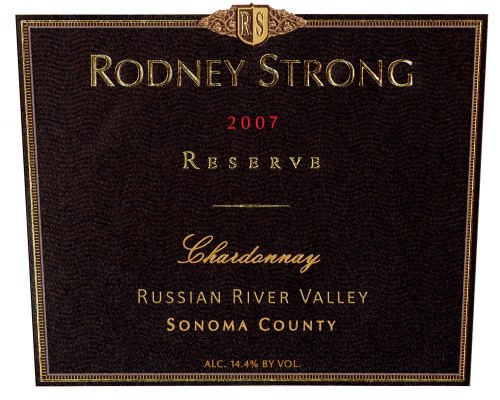 Apple pie aromas are joined by toast and hints of toffee on the layered and complex nose of this 2008 Chardonnay. Tropical fruits and hints of citrus appear on the palate which is loaded with apple and pear characteristics. Baked pie spices are plentiful as well. Minerals lead the lengthy finish which shows off toasty oak, bits of butter and a creaminess that brings to mind crème brulee. This wine is the epitome of California style Chardonnay; but to be crystal clear an example that is done remarkably well. The oak is well integrated but easily detectable and a key element like a prominent spice, however the fruit is still, as it should be the key. This wine is good on it’s own but excels paired with rich dishes.
Apple pie aromas are joined by toast and hints of toffee on the layered and complex nose of this 2008 Chardonnay. Tropical fruits and hints of citrus appear on the palate which is loaded with apple and pear characteristics. Baked pie spices are plentiful as well. Minerals lead the lengthy finish which shows off toasty oak, bits of butter and a creaminess that brings to mind crème brulee. This wine is the epitome of California style Chardonnay; but to be crystal clear an example that is done remarkably well. The oak is well integrated but easily detectable and a key element like a prominent spice, however the fruit is still, as it should be the key. This wine is good on it’s own but excels paired with rich dishes.
 Sparkling wine comes in all shapes and sizes. France of course has a legendary tradition when it comes to this style of wine. Today I’ll look at selection from Maison J.J. Vincent.
The Maison J.J. Vincent Cremant de Bourgogne was produced from fruit sourced in the Winery’s native Burgundy. More specifically the fruit comes from the southern reaches. This offering is composed entirely of Chardonnay. The fruit was handpicked during the earliest part of harvest. Vinification was accomplished using traditional methods for Sparkling Wine. This offering has a suggested retail price of $19.99.
Sparkling wine comes in all shapes and sizes. France of course has a legendary tradition when it comes to this style of wine. Today I’ll look at selection from Maison J.J. Vincent.
The Maison J.J. Vincent Cremant de Bourgogne was produced from fruit sourced in the Winery’s native Burgundy. More specifically the fruit comes from the southern reaches. This offering is composed entirely of Chardonnay. The fruit was handpicked during the earliest part of harvest. Vinification was accomplished using traditional methods for Sparkling Wine. This offering has a suggested retail price of $19.99. With summer almost over it’s time to get friends and family together for a few more BBQ’s before the weather turns cool. Large gatherings mean lots of mouths to feed and plenty of thirsts to quench. Historically a lot of jokes have been made about boxed wine. And for many years the commentary, criticism and humor were warranted. However in the last 5 years things have taken a pretty dramatic turn for the better. There are a number of producers now putting quality wine out in boxes. This is often referred to as the bag in the box. More often than not these are 3 Liter containers which equates to four standard size bottles. These wines generally sell for right around $20 give or take a couple of dollars based on brand and where you’re shopping. If you were purchasing these as stand alone bottles you could expect to pay somewhere from $6- $9 per bottle. In addition to saving some money with the three liter format a few other advantages are part of things as well. Eschewing glass makes them more environmentally friendly. Additionally if you don’t finish them up no worries as the bag in a box concept keeps the wine fresh for approximately 30 days. Make no mistake there are still plenty of anonymous boxed wines you’ll want to avoid, but now there are also some very solid go to choices. Today I’ll look at three that I recommend.
The Falling Star 2009 Chardonnay was produced from fruit sourced in the Mendoza region of Argentina. Falling Star is part of the Trapiche line and represents their budget label. After hand harvesting and fermentation the wine was ages in stainless steel tanks for approximately 6 months prior to a light filtration and bottling, This wine is available in 750 ml bottles, 1.5 L bottles and 3 Liter Boxes. I tasted out of 3 Liter box which has a suggested retail price of $19.99.
With summer almost over it’s time to get friends and family together for a few more BBQ’s before the weather turns cool. Large gatherings mean lots of mouths to feed and plenty of thirsts to quench. Historically a lot of jokes have been made about boxed wine. And for many years the commentary, criticism and humor were warranted. However in the last 5 years things have taken a pretty dramatic turn for the better. There are a number of producers now putting quality wine out in boxes. This is often referred to as the bag in the box. More often than not these are 3 Liter containers which equates to four standard size bottles. These wines generally sell for right around $20 give or take a couple of dollars based on brand and where you’re shopping. If you were purchasing these as stand alone bottles you could expect to pay somewhere from $6- $9 per bottle. In addition to saving some money with the three liter format a few other advantages are part of things as well. Eschewing glass makes them more environmentally friendly. Additionally if you don’t finish them up no worries as the bag in a box concept keeps the wine fresh for approximately 30 days. Make no mistake there are still plenty of anonymous boxed wines you’ll want to avoid, but now there are also some very solid go to choices. Today I’ll look at three that I recommend.
The Falling Star 2009 Chardonnay was produced from fruit sourced in the Mendoza region of Argentina. Falling Star is part of the Trapiche line and represents their budget label. After hand harvesting and fermentation the wine was ages in stainless steel tanks for approximately 6 months prior to a light filtration and bottling, This wine is available in 750 ml bottles, 1.5 L bottles and 3 Liter Boxes. I tasted out of 3 Liter box which has a suggested retail price of $19.99. The Folonari 2009 Fresh Cask Pinot Noir was made from fruit sourced in the Veneto. This Italian wine is 100% Pinot Noir. After fermentation 80% of the wine was aged for roughly 6 months in stainless steel, the remaining 20% in French oak barriques. This Pinot is available in 750 ml bottles, 1.5 liter bottles and 3 Liter boxes. The 3 Liter Box has a suggested retail price of $19.99.
The Folonari 2009 Fresh Cask Pinot Noir was made from fruit sourced in the Veneto. This Italian wine is 100% Pinot Noir. After fermentation 80% of the wine was aged for roughly 6 months in stainless steel, the remaining 20% in French oak barriques. This Pinot is available in 750 ml bottles, 1.5 liter bottles and 3 Liter boxes. The 3 Liter Box has a suggested retail price of $19.99.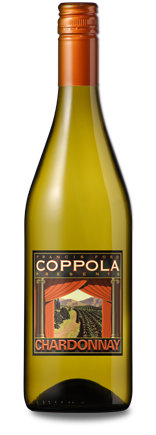 The
The  The Louis Jadot 2009 Pouilly-Fuisse was produced using fruit sourced in the southern part of Burgundy where a few tiny villages make up this sub-appellation. This offering is 100% Chardonnay. This wine has a suggested retail price around $22 and is currently
The Louis Jadot 2009 Pouilly-Fuisse was produced using fruit sourced in the southern part of Burgundy where a few tiny villages make up this sub-appellation. This offering is 100% Chardonnay. This wine has a suggested retail price around $22 and is currently 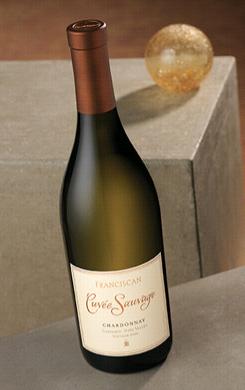 Carneros is one of the regions in California that has the ability to grow excellent Chardonnay. It seems that more and more folks on both the Napa and Sonoma side of things are looking to relatively cool climate Carneros when they source Chardonnay.
Carneros is one of the regions in California that has the ability to grow excellent Chardonnay. It seems that more and more folks on both the Napa and Sonoma side of things are looking to relatively cool climate Carneros when they source Chardonnay.  A number of years ago I first ran across a bottle of Pillar Box Red. This Australian blend was well priced and tasty. Since that time I’ve gone back to it on numerous occasions, recommended to people and had the opportunity to taste it alongside its winemaker. Most compelling for a wine in its price-point is how consistent its quality and general flavor profile has been from year to year. This isn’t often the case with wines around the $10 mark. Last week I had dinner with
A number of years ago I first ran across a bottle of Pillar Box Red. This Australian blend was well priced and tasty. Since that time I’ve gone back to it on numerous occasions, recommended to people and had the opportunity to taste it alongside its winemaker. Most compelling for a wine in its price-point is how consistent its quality and general flavor profile has been from year to year. This isn’t often the case with wines around the $10 mark. Last week I had dinner with 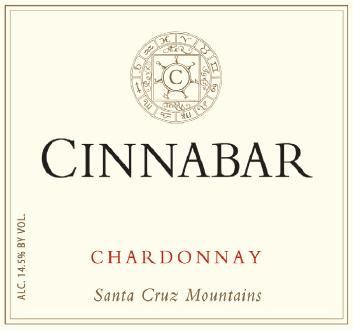 Pinot Noir and Chardonnay are the two varieties I personally associate with the Santa Cruz Mountains more than any other. A host of other varietals flourish there, but the two stars of Burgundy seem to benefit the most from the unique terroir up there. Today I’ll look at a current release Chardonnay from
Pinot Noir and Chardonnay are the two varieties I personally associate with the Santa Cruz Mountains more than any other. A host of other varietals flourish there, but the two stars of Burgundy seem to benefit the most from the unique terroir up there. Today I’ll look at a current release Chardonnay from 
 Nals Margreid 2007 Pinot Grigio Punggl DOC Alto Adige. This single vineyard wine is 100% Pinot Grigio. Half of the grapes for this wine were fermented and aged in large oak barrels, the other half in stainless steel tanks. At release this wine had a suggested retail price of $24. The 2009 is the current vintage of this particular wine. The 2007 features lots of yellow fruit flavors throughout a round and sweet but well balanced palate. It shows off the juicy flavors that are prevalent with relatively small production Pinot Grigio treated with care; as opposed to the vast array of anonymous Pinot Grigio that hits US shelves by the boatload.
Nals Margreid 2007 Pinot Grigio Punggl DOC Alto Adige. This single vineyard wine is 100% Pinot Grigio. Half of the grapes for this wine were fermented and aged in large oak barrels, the other half in stainless steel tanks. At release this wine had a suggested retail price of $24. The 2009 is the current vintage of this particular wine. The 2007 features lots of yellow fruit flavors throughout a round and sweet but well balanced palate. It shows off the juicy flavors that are prevalent with relatively small production Pinot Grigio treated with care; as opposed to the vast array of anonymous Pinot Grigio that hits US shelves by the boatload.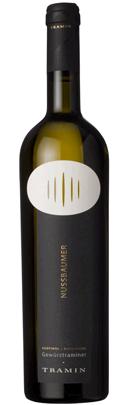 $40. Apple, limestone and minerals are all present on this wine. Its overall style in many ways brings to mind aged Burgundy. The purity of fruit and length of finish are both impressive.
$40. Apple, limestone and minerals are all present on this wine. Its overall style in many ways brings to mind aged Burgundy. The purity of fruit and length of finish are both impressive.  In the early 90’s when I first started visiting Napa Valley a handful of producers were of specific interest to me. I’d visit them time and again because they had one or more wines that I enjoyed regularly and I was also always eager to taste smaller production things that I couldn’t get on my shelf back home. Franciscan Estate was one of those producers. Their Cabernet Sauvignon, Merlot and Chardonnay were the three wines I drank with the most regularity, but I really enjoyed the majority of their portfolio quite a bit. As happens from time to time they slipped off my radar a bit of late. The number of wines out there are practically dizzying in number, making it difficult to always go back and revisit. So when current releases of Chardonnay and Sauvignon Blanc from Franciscan landed on my desk recently it felt like it does when an old friend you haven’t seen in awhile calls or rings your doorbell, or these days, pokes you on Facebook. Regardless of how they reach out, the reaction is usually the same you want to know how they’re doing. And that was exactly what I was wondering about
In the early 90’s when I first started visiting Napa Valley a handful of producers were of specific interest to me. I’d visit them time and again because they had one or more wines that I enjoyed regularly and I was also always eager to taste smaller production things that I couldn’t get on my shelf back home. Franciscan Estate was one of those producers. Their Cabernet Sauvignon, Merlot and Chardonnay were the three wines I drank with the most regularity, but I really enjoyed the majority of their portfolio quite a bit. As happens from time to time they slipped off my radar a bit of late. The number of wines out there are practically dizzying in number, making it difficult to always go back and revisit. So when current releases of Chardonnay and Sauvignon Blanc from Franciscan landed on my desk recently it felt like it does when an old friend you haven’t seen in awhile calls or rings your doorbell, or these days, pokes you on Facebook. Regardless of how they reach out, the reaction is usually the same you want to know how they’re doing. And that was exactly what I was wondering about 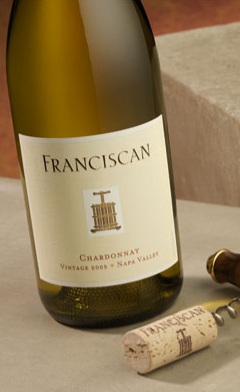 The Franciscan Estate 2009 Chardonnay was produced using fruit sourced in Carneros and southern Napa Valley. This wine is 100% Chardonnay. Fermentation took place in barrel followed by 7 months of aging in small French and American oak barrels; 20% of them were new. Just fewer than 59,000 cases of this wine were produced and it has a suggested retail price of $18.
The Franciscan Estate 2009 Chardonnay was produced using fruit sourced in Carneros and southern Napa Valley. This wine is 100% Chardonnay. Fermentation took place in barrel followed by 7 months of aging in small French and American oak barrels; 20% of them were new. Just fewer than 59,000 cases of this wine were produced and it has a suggested retail price of $18.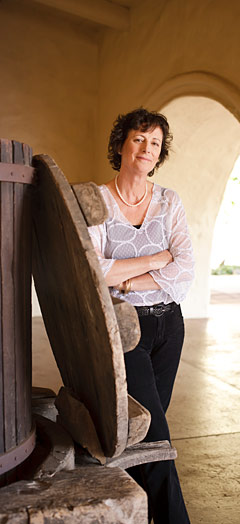 As we’ve grown precipitously as a wine drinking nation over the last couple of decades our choices have also increased. The number of outlets selling wine is way up and the options we have once we go there are in sharp contrast to what was available a number of years ago. The temptation in our culture is also to chase the new hot thing. Sometimes that leaves little room to reconsider or reconnect with something we already love. In this case that something is the
As we’ve grown precipitously as a wine drinking nation over the last couple of decades our choices have also increased. The number of outlets selling wine is way up and the options we have once we go there are in sharp contrast to what was available a number of years ago. The temptation in our culture is also to chase the new hot thing. Sometimes that leaves little room to reconsider or reconnect with something we already love. In this case that something is the 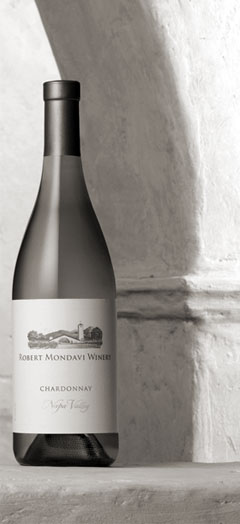 The event took place at
The event took place at 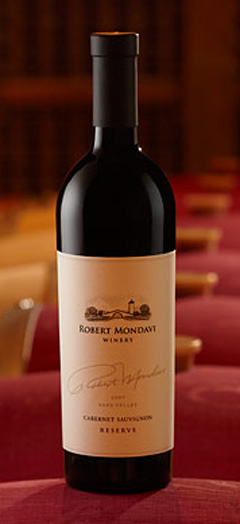 The Robert Mondavi Winery 2007 Cabernet Sauvignon was made entirely with fruit from Oakville and 93% of it from To Kalon. This wine is bigger, bolder and a bit brasher today. It has firm tannins that need some time in the bottle or some aeration to soften a bit. The elements which make the 1996 so drinkable today are also there in the 2007. It’s simply loaded with fruit and spice flavors that are accented by the time spent in barrel. Just less than 10,000 cases were produced and it has a suggested retail price of $135. Ultimately, the 2007 has the hallmarks of a wine that promises to be an even more impressive effort than the 1996. The question after purchasing it is if you have patience. It’s very enjoyable now, particularly with full flavored foods. However if you give it 5 or 10 years of proper storage you’ll be rewarded with a slightly mellower, more resolved wine that will just knock your socks off. You really can’t go wrong either way, it depends which experience you prefer.
The Robert Mondavi Winery 2007 Cabernet Sauvignon was made entirely with fruit from Oakville and 93% of it from To Kalon. This wine is bigger, bolder and a bit brasher today. It has firm tannins that need some time in the bottle or some aeration to soften a bit. The elements which make the 1996 so drinkable today are also there in the 2007. It’s simply loaded with fruit and spice flavors that are accented by the time spent in barrel. Just less than 10,000 cases were produced and it has a suggested retail price of $135. Ultimately, the 2007 has the hallmarks of a wine that promises to be an even more impressive effort than the 1996. The question after purchasing it is if you have patience. It’s very enjoyable now, particularly with full flavored foods. However if you give it 5 or 10 years of proper storage you’ll be rewarded with a slightly mellower, more resolved wine that will just knock your socks off. You really can’t go wrong either way, it depends which experience you prefer. During a summer 2009 trip to Napa Valley a friend recommended
During a summer 2009 trip to Napa Valley a friend recommended  Thomas Fogarty Winery
Thomas Fogarty Winery The Thomas Fogarty 2007 Estate Chardonnay was produced using barrel selection from two of their estate vineyards; Damiana and Langley Hill. Half of the fruit comes from each vineyard. This wine was aged in French oak for 16 months; 30% of the barrels were new. This wine has a suggested retail price of $37.
The Thomas Fogarty 2007 Estate Chardonnay was produced using barrel selection from two of their estate vineyards; Damiana and Langley Hill. Half of the fruit comes from each vineyard. This wine was aged in French oak for 16 months; 30% of the barrels were new. This wine has a suggested retail price of $37. The Thomas Fogarty 2007 Albutom Estate Chardonnay is a single vineyard offering. 100% of the fruit was sourced from the namesake vineyard. Albutom Vineyard sits 10 miles from the ocean at an elevation of 1930 feet. This wine was aged for 18 months in French oak; 50% of the barrels were new. Fewer than 50 cases of this selection were produced and it sells for $48.
The Thomas Fogarty 2007 Albutom Estate Chardonnay is a single vineyard offering. 100% of the fruit was sourced from the namesake vineyard. Albutom Vineyard sits 10 miles from the ocean at an elevation of 1930 feet. This wine was aged for 18 months in French oak; 50% of the barrels were new. Fewer than 50 cases of this selection were produced and it sells for $48.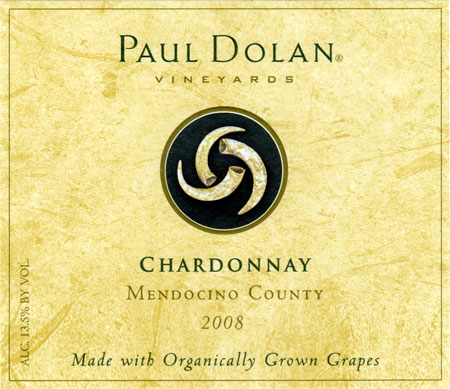 The Paul Dolan Vineyard 2008 Chardonnay was produced entirely from Mendocino County fruit. Fruit was sourced from two vineyards, each planted in the early 1970’s. This wine is 100% varietal. 20% of the wine underwent oak barrel aging for 8 months; the remaining 80% was aged in stainless steel. 3,080 cases of this offering were produced and it has a suggested retail price of $18.
The Paul Dolan Vineyard 2008 Chardonnay was produced entirely from Mendocino County fruit. Fruit was sourced from two vineyards, each planted in the early 1970’s. This wine is 100% varietal. 20% of the wine underwent oak barrel aging for 8 months; the remaining 80% was aged in stainless steel. 3,080 cases of this offering were produced and it has a suggested retail price of $18.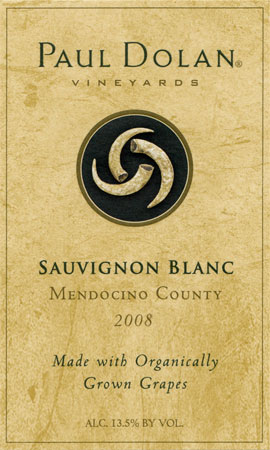 The Paul Dolan Vineyards 2008 Sauvignon Blanc was produced using fruit from two neighboring vineyards located at the headwaters of the Russian River in Mendocino County. This offering is 100% Sauvignon Blanc; it was both fermented and aged in stainless steel. 1,260 cases of this wine were produced and it has a suggested retail price of $18.
The Paul Dolan Vineyards 2008 Sauvignon Blanc was produced using fruit from two neighboring vineyards located at the headwaters of the Russian River in Mendocino County. This offering is 100% Sauvignon Blanc; it was both fermented and aged in stainless steel. 1,260 cases of this wine were produced and it has a suggested retail price of $18.